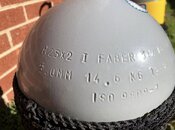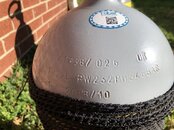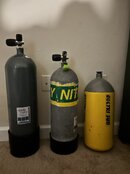mdsnorkelson
New
Hey everybody,
I recently purchased two used Faber steel scuba tanks, and I've run into something interesting with them. Both tanks appear to be identical in size, but the markings on the neck are unlike anything I'm used to here in North Carolina, USA. I suspect they might have UK markings, as they don't have the usual PSI or cubic foot notation that I'm used to. I'm reaching out to the community for help identifying their volume in cubic feet.
I've included photos of the neck inscription. One of the tanks has much clearer inscriptions, as the other looks like it may have been painted, and has a glossier finish. I've also taken a photo of one of one of the tanks next to my Worthington X7-100 and my Faber FX100 to give a sense of its size (the tank in question is the shortest in height).
Thanks to any help you can provide.
Cheers,
Snorkelson
(edit): I see that only 5 image attachments is allowed, so I will include photos of the more clearly inscribed tank, and the size comparison.
I recently purchased two used Faber steel scuba tanks, and I've run into something interesting with them. Both tanks appear to be identical in size, but the markings on the neck are unlike anything I'm used to here in North Carolina, USA. I suspect they might have UK markings, as they don't have the usual PSI or cubic foot notation that I'm used to. I'm reaching out to the community for help identifying their volume in cubic feet.
I've included photos of the neck inscription. One of the tanks has much clearer inscriptions, as the other looks like it may have been painted, and has a glossier finish. I've also taken a photo of one of one of the tanks next to my Worthington X7-100 and my Faber FX100 to give a sense of its size (the tank in question is the shortest in height).
Thanks to any help you can provide.
Cheers,
Snorkelson
(edit): I see that only 5 image attachments is allowed, so I will include photos of the more clearly inscribed tank, and the size comparison.






